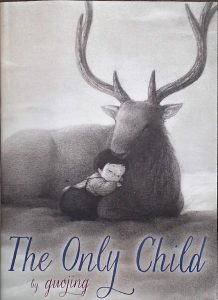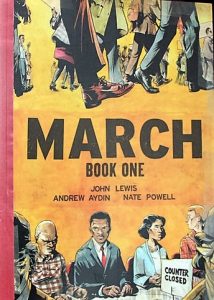
Author: Margaret Hillert
Illustrator: Donald Charles
Publishing Information: Modern Curriculum Press, 1981
Number of Pages: 32
Genre: Folktale
Analysis:

The Little Cookie is a classic tale of an elderly woman who bakes a cookie that comes to life as she finishes making him. Once he realizes he is alive and active, he runs off across the land meeting a variety of new animals and taking in all the scenery he could not have otherwise seen if he was confined to the kitchen. His adventure comes to an end after he accepts a ride across the stream from a sneaky fox, leaving readers to conclude for themselves what happens next.
The story only uses a total of forty eight basic words, which are counted and listed in a guide at the end of the book, which evidences that it is a story meant for beginning readers to enjoy. Furthermore, the text is rather repetitive as the cookie goes along his different adventures, making it an easy and fun read for younger children.
The illustrations are done in brighter colored paint, reflecting the lighthearted and fun tone of the story as the cookie goes about his adventure out of the kitchen. He is typically featured on the right-hand side of the page, which interested me because he had seemed so free and excited throughout the story. This leads me to believe that perhaps he is not as secure as one may believe him to be, since he is unfamiliar in the outside world. It is not until the very end (when the fox is giving him a ride across the stream) that the cookie is featured on the left-hand side of the page, although they are moving to the right. This could show that although the cookie thinks he is secure, he is headed toward danger as the fox has other plans for him. There are some instances in which the text does not even inform the reader of who is doing the speaking, which leads me to conclude that the story is mostly a picture book narrative where the pictures could tell the story with little to no help from the text.
Although there is certainly the ideology of the dangers of wandering away from one’s caretaker demonstrated in the story, I feel as though this is mostly a fun book to engage beginning readers.






 Salesman Mr. Al Foxword claims that he can sell anyone anything, even the book that is being read. Al isn’t very convincing, but by the end of the book, the reader still feels like they have to buy the book.
Salesman Mr. Al Foxword claims that he can sell anyone anything, even the book that is being read. Al isn’t very convincing, but by the end of the book, the reader still feels like they have to buy the book.
 A lonely, only child runs away from home and finds a mysterious stag that takes her to a magical world. In this world, she feels loved and eventually misses home. Guojing takes us through the young girl’s journey back home to her family.
A lonely, only child runs away from home and finds a mysterious stag that takes her to a magical world. In this world, she feels loved and eventually misses home. Guojing takes us through the young girl’s journey back home to her family.
 In March: Book One John Lewis tells about the struggle he has gone through and witnessed since the beginning days of segregation. He highlights the highs and lows of the Civil Rights Movement, and how much influence he had in the process.
In March: Book One John Lewis tells about the struggle he has gone through and witnessed since the beginning days of segregation. He highlights the highs and lows of the Civil Rights Movement, and how much influence he had in the process.
 This dirty pigeon uses sarcasm and reverse psychology to get out of taking a bath. When his tactics don’t work and he is forced to take a bath, he realizes that baths aren’t so bad after all.
This dirty pigeon uses sarcasm and reverse psychology to get out of taking a bath. When his tactics don’t work and he is forced to take a bath, he realizes that baths aren’t so bad after all.
 Flashlight is about a young boy who explores the mysterious world outside of his tent. What other way to experience nature than with a flashlight? Like a flashlight, this book helps us experience the beauties of nighttime nature.
Flashlight is about a young boy who explores the mysterious world outside of his tent. What other way to experience nature than with a flashlight? Like a flashlight, this book helps us experience the beauties of nighttime nature.![IMG_9670 [2578141]](https://blogs.iwu.edu/lrbmt2016/files/2016/05/IMG_9670-2578141-218x300.jpg)
![IMG_9671 [2578142]](https://blogs.iwu.edu/lrbmt2016/files/2016/05/IMG_9671-2578142-188x300.jpg) When an unwanted ghost boy, Leo, is “evicted” from his ghost home, he is forced to live on the streets. It isn’t until he meets a young, believing girl that he finally feels accepted and seen.
When an unwanted ghost boy, Leo, is “evicted” from his ghost home, he is forced to live on the streets. It isn’t until he meets a young, believing girl that he finally feels accepted and seen.![IMG_9673 [2578143]](https://blogs.iwu.edu/lrbmt2016/files/2016/05/IMG_9673-2578143-197x300.jpg)
![IMG_9675 [2578144]](https://blogs.iwu.edu/lrbmt2016/files/2016/05/IMG_9675-2578144-197x300.jpg) A rabbit is skeptical about what his new otter neighbors will be like. He is told to treat them as he would want them to treat him. After realizing how he’d like to be treated, he sees that maybe his new neighbors won’t be so bad after all.
A rabbit is skeptical about what his new otter neighbors will be like. He is told to treat them as he would want them to treat him. After realizing how he’d like to be treated, he sees that maybe his new neighbors won’t be so bad after all.